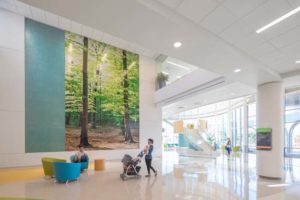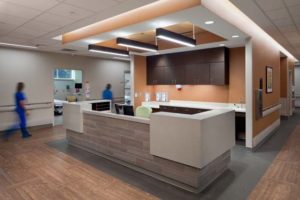2018 Design Showcase: High Points
Each project submitted to the Healthcare Design Showcase is judged on four criteria: innovation, collaboration, aesthetics, and functionality/operational performance. Here, we highlight some of the top-scoring projects in our individual categories and some details on the features our jury applauded.
COLLABORATION
Texas Children’s Hospital, The Woodlands Campus, The Woodlands, Texas
Submitted by FKP/CannonDesign
Residents of The Woodlands, Texas, previously faced an 80-mile round-trip to visit the Texas Children’s Hospital (TCH) Texas Medical Center campus in Houston. This satellite facility solves that issue, while also fitting in perfectly in its new home. The design uses a “spirit of the woods” theme, a nod to the area’s integration of residential neighborhoods, nature trails, and parks within the wooded setting. Community members were highly involved in visioning and planning, too. TCH and the design team engaged them throughout the project, allowing participants to vet design decisions, resulting in enthusiastic collaboration and support for the new hospital. (photo credit: © Slyworks Photography)


Florida Hospital Apopka, Apopka, Fla.
Submitted by ESa (Earl Swensson Associates)
Meetings with users were held throughout each phase of the project, with staff members involved before and after construction through biweekly tours that allowed them to view the progress firsthand. Additionally, the local community was engaged via planning meetings open to residents. To demonstrate its commitment to enhancing local aesthetics, the owner turned the traditional groundbreaking ceremony into a “ground making” by planting trees. The City of Apopka even posted drone footage of construction to its Facebook page to keep residents updated on building progress. (photo credit: ©2018 Attic Fire Photography, courtesy of ESa)

Tanner Medical Center/East Alabama, Wedowee, Ala.
Submitted by Earl Architects LLC
From the conception of this project, the community of Wedowee, Ala., showed immense support for it, even passing a special referendum to fund the microhospital. Additionally, local leaders partnered with Tanner Health System to help staff and operate the facility and also agreed to cover the cost of equipment and furnishings. Local artists created and donated artwork, while staff weighed in on clinical and patient needs. Collaboration between team members was essential, too, as an accelerated schedule required design to be completed in four months. Keys to success were constant communication with administrators and fostering a partnership-based relationship with the entire project team. (photo credit: Kieran Reynolds @ Kieran Reynolds Photography)

AESTHETICS
The Birth Place at Olathe Medical Center, Olathe, Kan.
Submitted by HMN Architects, JE Dunn Construction, and Brack & Associates Consulting Engineers P.A.
A palette of earth tones delivered via stone veneer, cedar planks, slate tile, terrazzo flooring, and wood-look luxury vinyl tile deliver a soothing setting, while shades of blue are used for wayfinding elements to provide contrast. Postpartum patient rooms feature a hospitality aesthetic with custom cabinetry in rich wood tones surrounding a queen-size Murphy bed, while the bathrooms feature edge-lit mirrors and decorative wall tiles. An extensive use of glass affords sweeping views from the waiting areas inside. (photo credit: ©2017 Bob Greenspan Photography)


Advocate Outpatient Center—Des Plaines, Des Plaines, Ill.
Submitted by HDR and Boldt Construction
Materials selected for this project were informed by the local context, including precast concrete and brick similar to those used in the surrounding neighborhood. However, those materials were elevated through thoughtful approaches such as subtle brick projections that are amplified by the sun and precast masonry units of varying aggregates and colors. Inside, color-coded onstage corridor portals deliver subtle wayfinding cues, with the pediatric area using the same technique with a dash of whimsy in graphics. Views to the outside community are plentiful, offering visitors spaces flooded with natural light. (photo credit: © Tom Harris/HDR)

FUNCTIONALITY/OPERATIONAL PERFORMANCE
Methodist Mansfield Medical Center, Mansfield, Texas
Submitted by CallisonRTKL
As an addition and renovation of an existing patient tower, the project was fueled by a goal of achieving continuous improvement, gaining whole-system optimization, and maximizing value. Part of delivering that was a review of current patient floor plans with nurses, physicians, and hospital leaders to identify areas in need of improvement for operational performance. Lean exercises such as collaborative work sessions and value-stream mapping were performed with staff to identify operational waste. A finished patient room mock-up was also completed. These exercises led to several solutions, including the redesign of support spaces to be accessible from both sides of the patient floor; reducing staff travel distances and time spent collecting supplies; and repositioning nurse sinks in the patient room to the footwall to clear more countertop space and allow for a larger opening into the room for transport. (photo credit: ©2016 Charles Davis Smith, AIA)

Cleveland Clinic Avon Inpatient Bed Tower, Avon, Ohio
Submitted by DLR Group
An expansion and renovation of an existing health center and ambulatory surgery center to add 114 med/surg patient rooms and 12 ICU rooms, the project leverages flexibility and technology throughout. A researcher and his team were engaged to focus on the design of the patient room, working with more than 1,800 patients, staff members, and others, with findings guiding the ultimate design. Lean principles were also used. For example, patient, material, and support services processes were mapped and evaluated and then compared to existing enterprise resources and services to avoid duplication. Materials management was adjusted to just-in-time delivery, resulting in a 15 percent reduction in space compared to the average U.S. acute care hospital. Although a POE will be conducted, preliminary anecdotal results show enhanced levels of service delivered by providers that’s attributed to patient room standardization and increased collaboration among the medical staff thanks to interdisciplinary workstations. (photo credit: ©2018 Kevin G. Reeves; Courtesy of DLR Group |Westlake Reed Leskosky)

Memorial Medical Center Patient Care Tower and Surgery Expansion, Springfield, Ill.
Submitted by BSA LifeStructures
The project included a new patient tower and surgery addition/renovation, and plenty of operational goals to go with them. Post-occupancy data already shows efforts paid off, too. For example, a goal of decreasing staff travel distance in the patient tower was achieved, with a 7.7 percent decrease in travel time. Safety in patient bathrooms was also a key focus, and falls have been reduced by 24 percent. Additionally, HAIs have been significantly reduced and surgery patient satisfaction has increased. The team also identified more than 100 energy-efficiency measures to implement in the existing facilities. (photo credit: © Alise O’Brien Photography)


INNOVATION
Taikang Tongji Wuhan Hospital, Wuhan, China
Submitted by HKS Inc.
A project-in-progress, Taikang Tongji Wuhan Hospital will serve both “VIPs” as well as a general patient population with its 1,100 beds. To that end, the design strives to invite the public to experience opportunities of wellness and retail, connecting to adjacent neighborhoods and a nearby canal system to become a local amenity space. A series of courtyards ties clinics on campus with the hospital, creating hubs of activity. The project’s towers will be built in a pinwheel pattern that radiates from a central core, with clinics oriented toward an internal courtyard and a women’s building placed so postpartum patients have access to rooftop gardens.

Advocate Outpatient Center – Des PlainEs, Des Plaines, Ill.
Submitted by HDR and Boldt Construction
The project is based on a prototype developed with an eye on efficient operations, patient engagement, sustainability, and technology—all while being flexible and adaptable. A core module was created that’s repeatable and scalable, while a continual learning process will allow successive clinics to be adjusted based on how previous iterations perform. This model, dubbed Care360, focuses on how people connect to health, wellness, and well-being via a chassis that includes 12 exam rooms, workstations, touchdown areas, and shared common spaces such as waiting and registration. Additionally, plentiful outdoor spaces offer patients and visitors a better waiting experience and staff a place of respite. (photo credit: © Tom Harris/HDR)

